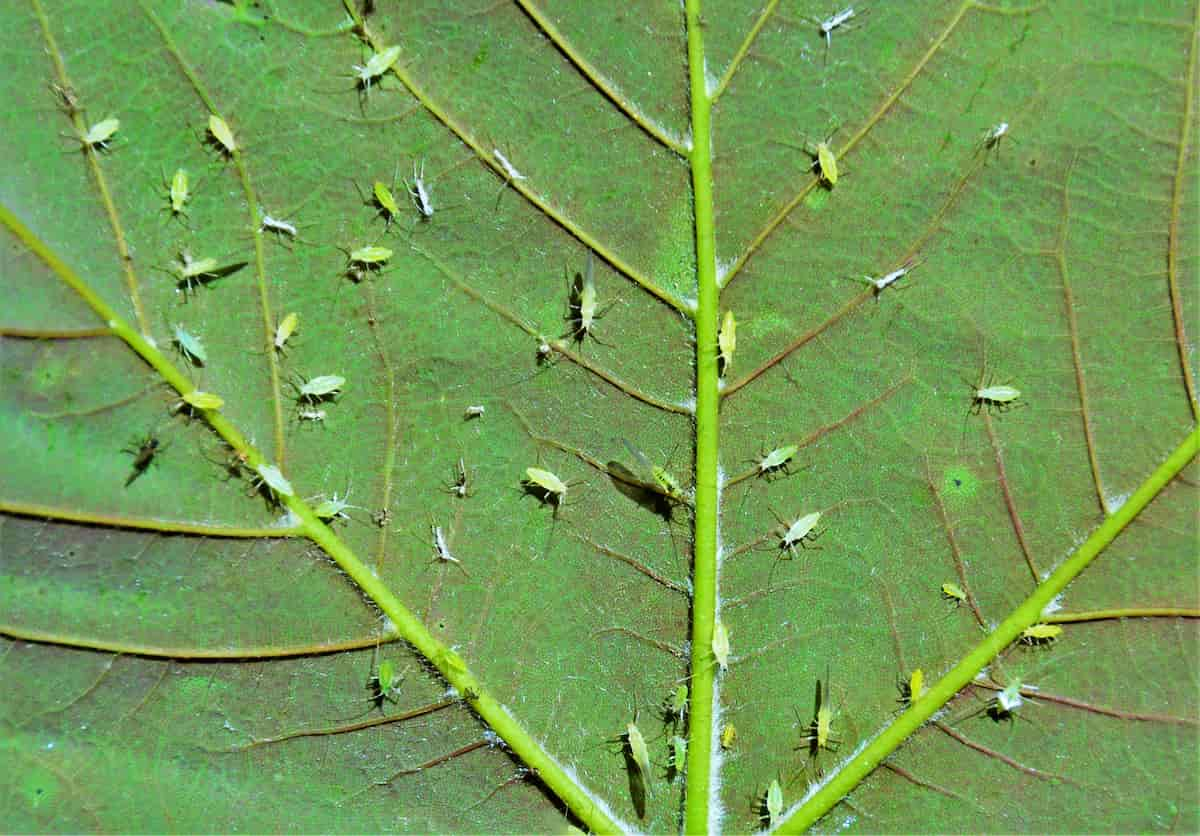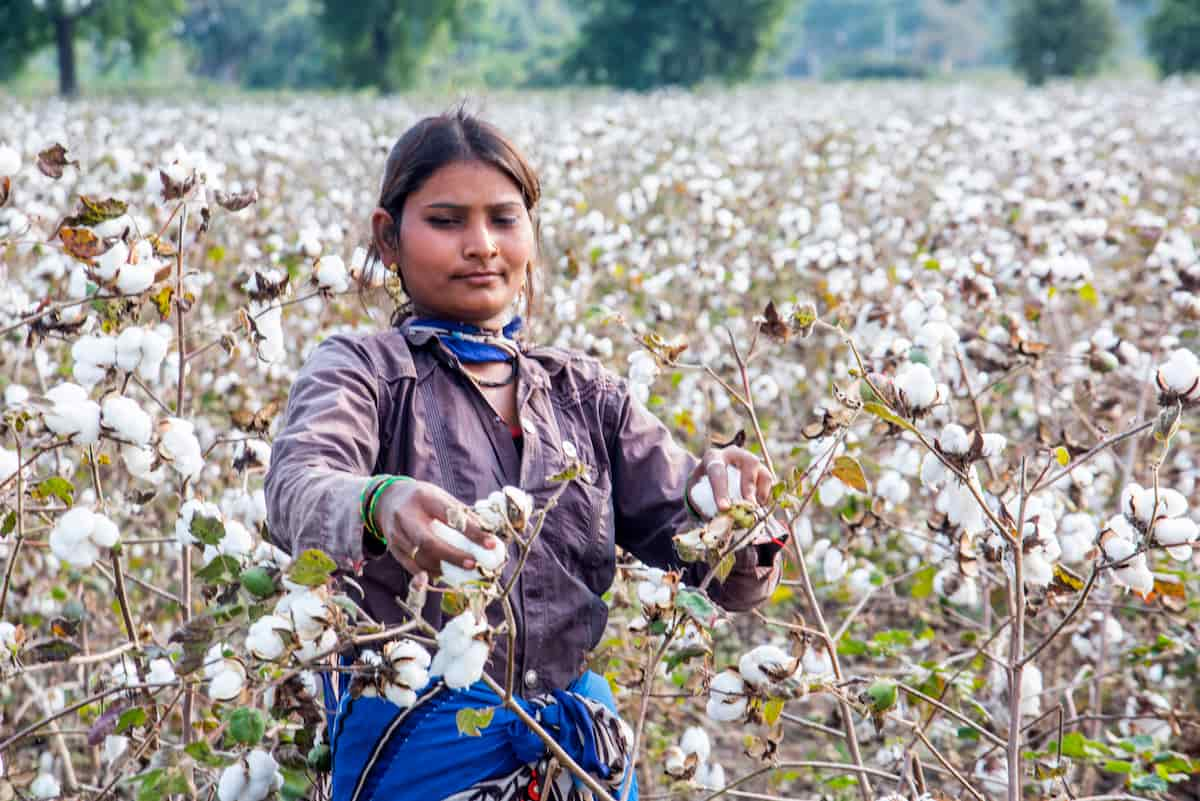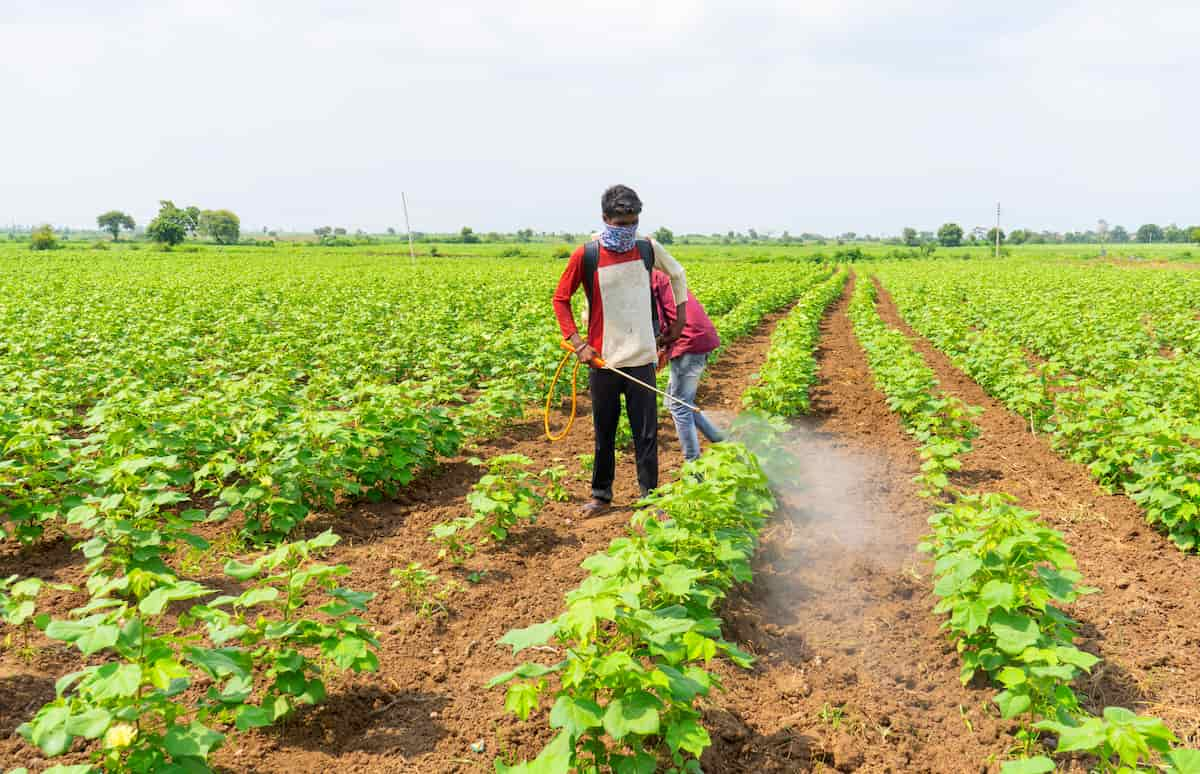The cotton aphid, also known as Aphis gossypii, is a small insect belonging to the Aphididae family. India’s cotton is a major cash crop vulnerable to insect attacks at all stages of its growth. Among the sucking pests, cotton aphids pose a significant threat due to their ability to damage the cotton plant’s leaves, stems, and buds, leading to reduced growth and yield. It feeds on the plant’s sap, which can cause the affected leaves’ yellowing, curling, and stunted growth.

In addition, they excrete a sticky, sugary substance known as honeydew that attracts fungi, which can further harm the plant by causing black sooty mold to form on the branches and leaves. This mold can reduce the plant’s photosynthetic ability and lower the quality of the cotton fibers. Cotton aphids can also transmit plant viruses, making them a significant threat to cotton production.
Aphid management in Cotton
The life cycle of Cotton Aphid
The life cycle of the cotton aphid (Aphis gossypii) includes the following stages: egg, nymph, and adult.
- Egg: Female cotton aphids reproduce asexually and give birth to live young without mating. Some females may lay eggs for overwintering, which hatch into nymphs in the spring.
- Nymph: The nymphs that hatch from eggs or are born directly from a female resemble adult cotton aphids in appearance but are smaller and lack wings. They feed on the sap of cotton plants, molt several times as they grow, and eventually mature into adults.
- Adult: Upon reaching maturity, cotton aphids are fully-formed, winged insects that can fly and spread to new plants. They continue to feed on the sap of cotton plants and reproduce asexually, giving birth to live young.
The high reproductive rate of cotton aphids and their ability to damage cotton plants and transmit viruses make them a significant threat to cotton production.
Identification of the Cotton Aphid
Cotton aphids (Aphis gossypii) are little, soft-bodied insects that live on the undersides of leaves. The nymphs are yellowish or greenish brown in hue, whereas the adults are slightly bigger and greenish brown. When the cotton aphid population grows too thick, and there is a need to colonize new plants, winged variants of the cotton aphid may arise. Aphid insects feed on plant sap and can harm cotton crops by lowering yields and quality.
In case you missed it: Fruit Borer (Helicoverpa) Management in Cotton: Symptoms, Treatment, Chemical, Biological, Natural, and Organic Control

Symptoms of damage by Cotton Aphid
- Manifestation of the damage
- Infesting the young, tender shoots as well as the undersides of the leaves
- The wrinkling and curling of the leaves
- The growth that is stunted
- The look of being blighted when the infestation is severe
- The dark color of the plant is caused by the development of black sooty mold, which is caused by the excretion of honeydew.
Impact/ Favorable conditions for Cotton Aphid growth in Cotton crop
Cotton Aphids can cause significant yield loss if their populations are not controlled in time. If more than 90% of plants are infested for 2-3 weeks, it can result in a substantial loss of yield. Dry and warm conditions are ideal for their development. They often gather in bunches and feed on the undersides of well-fed young leaves and stem tips. They puncture sensitive plant tissues with their long mouthparts and suck out juices.
Farmers should look at the estimated yield loss, the cost of control, and the price of cotton to decide if they need to take action. If open bolls are present, the threshold for controlling the aphid population should be lowered to 50% of plants infested or 10% if honeydew is present. It is important to prevent the contamination of lint, which can lower the cotton quality.
Cotton Aphid management in Cotton by cultural method
Cotton aphid infestations are more common in late-planted cotton and in well-watered and fertilized. Excessive or poorly timed nitrogen applications can also amplify aphid damage. Specific cotton cultivars are more vulnerable to aphids and should be avoided while growing cotton. Cotton aphid damage may be reduced by considering the planting time, water and fertilizer management, and cultivar selection.
Cotton Aphid management in Cotton by biological method
In the early stages of cotton growth, natural enemies like wasps and lady beetles help control aphid populations. Later, other bugs and fungi offer some control but are only sometimes effective in reducing the aphid population. Releasing more green lacewings is not a good solution as they may eat each other.
Cotton Aphid management in Cotton by chemical method
- Chemical pesticides can cause aphid resistance, so alternative control methods should be considered.
- Stem/ Foliar application with flonicamid and water (1:20) ratio at 30, 45, and 60 days after sowing can be used.
- Other insecticides, such as Fipronil, Thiamethoxam, Flonicamid, and Acetamiprid, can also be used.
Recommended insecticides for spray application
- Methyl demeton 25 EC at a rate of 500 ml/ha
- Dimethoate 30 EC at a rate of 500 ml/ha
- Acetamiprid 20% SP at a rate of 50 g/ha
- Azadirachtin 0.03% EC at a rate of 500 ml/ha
- Buprofezin 25% SC at a rate of 1000 ml/ha
- Carbosulfan 25% DS at a rate of 60 g/kg of seed.
In case you missed it: Pink Bollworm Management in Cotton: Symptoms, Treatment, Chemical, Biological, Natural, and Organic Control

Cotton Aphid management in Cotton by organic/natural method
One effective technique is insecticidal soap solutions or solutions based on plant oils, such as neem oil. To make the solution, combine 3 mL of neem oil and 1 liter of water. This solution can be sprayed directly on the afflicted plants to reduce the aphid population. Another method is to take advantage of aphids’ vulnerability to fungal illnesses in humid environments. A water spray on the damaged plants might promote the establishment of these fungal infections, lowering the aphid population.
Preventive measures for control of Cotton Aphid
Farmers can take several preventive measures to avoid Cotton Aphid infestations. Maintaining a diverse array of plant species around fields, clearing plant residue from previous harvests, using reflecting mulches to discourage invading aphids, and periodically monitoring fields to gauge disease and pest severity are all examples of these practices. Other necessary steps include:
- Removing infected plant parts.
- Controlling weeds.
- Avoiding overwatering and overfertilizing.
- Reducing the number of ants that protect aphids.
- Letting plants breathe by pruning or removing the bottom leaves.
- Using protective nets when possible.
- Limiting the use of insecticides so they don’t hurt good bugs.
Conclusion
Cotton aphid management involves monitoring symptoms, using treatments like insecticidal soaps or plant oils, and implementing chemical, biological, natural, and organic control methods. Avoiding over-fertilization, selecting resistant cultivars, and promoting natural predators can help prevent infestations.
- Deworming Schedule for Dogs/Puppies: A Beginners Guide
- How to Prevent and Control Parasites in Goats
- Beneficial Insects in Pest Management
- Natural Solutions for Pest Control in Flower Gardens
- Types of Fungicides Used in Agriculture
- Common Issues in the Fruit Development Stage of Pomegranate Farming
- Fruit Development Issues in Papaya: Easy Solutions and Treatment
- Soil-Borne Diseases and How to Protect Your Plants
- Practices to Prevent Disease Spread in the Garden